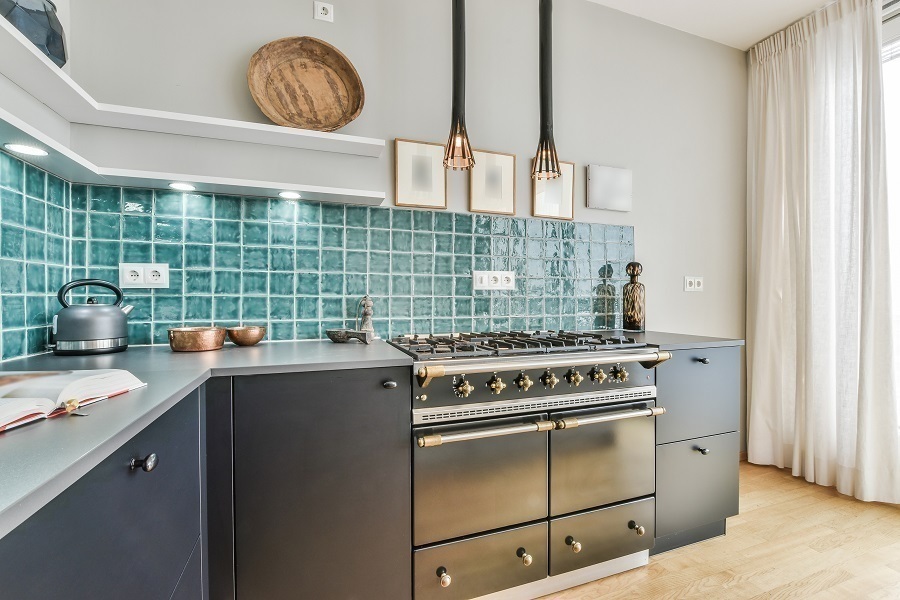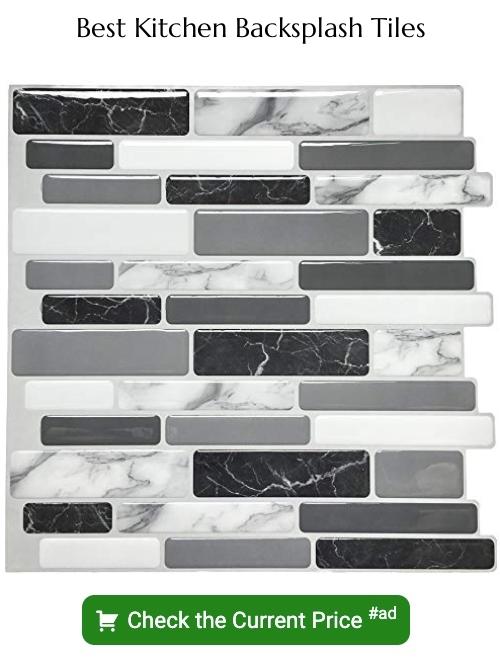Last updated on
Installing a kitchen backsplash, you have an important question to answer before you even begin your project. Where do you end your backsplash? Here’s the answer.
In short, you should look for a natural stopping point. This could be the end of the cabinets and countertops, the edge of the wall, a window, or the ceiling.
What you choose depends on the layout of the kitchen. So we delve deeper and consider several typical cases where the backsplash should end in the kitchen without looking odd.
Let’s begin with the basic guidelines.
What's Inside
Basic Guidelines for Kitchen Backsplash Placement

It is important to figure out where you will end your backsplash because you want to know how many tiles you will need to install it. In a nutshell, here’s a guide to where a backsplash should go.
While the most obvious placement of the kitchen backsplash is between the upper and lower cabinets, it isn’t as clear if you don’t have the typical layout. Where to end the backsplash horizontally also raises an interesting design conundrum.
For less explicit reasons to place the backsplash, you can reference these guidelines:
- It’s obvious that the backsplash should go where you cook your food, i.e. on the wall behind the stove and food prep countertops. The more of the wall you cover the better.
- Place the backsplash between the upper and lower cabinet cabinets. It connects the two sets, which makes the room look bigger and more prominent.
- Do place a backsplash behind your cooktop and hood vent. If you have an accent tile, that will be shown more because of grease, bubbling sauce, and steam coming from your stove. It eliminates the headache for cleaning by having the backsplash there.
- Do not install backsplash behind big appliances such as the fridge because no one will able to see it anyway and it doesn’t protect the walls. The purpose of the backsplash is to protect the wall from splatter and as a decorative accent. It servse none of its purpose if it’s hidden anyway.
Natural Stopping Point
The best thing to do is to find which point on the backsplash feels most natural for the edges. This could be an edge of a wall, an edge of windows, or anything that interrupts what otherwise is a straight path for the backsplash. Another option would be using decorative tiles as edging trim or bull-nosed trim from tiles and create an eyebrow-like shape across where you want your backsplash to stop.
Run the Backsplash to the Ceiling
If there are no upper cabinets, you have the option to run the backsplash up to the ceiling. Some people choose to take the tile all the way up to their ceilings. This makes it look taller, and certain items stand out, such as open shelves within a kitchen.
Create a Focal Point
Since the backsplash makes up most of the wall area in a kitchen, consider making it a focal point. You can add vertical mosaics or accent tiles to make your design completely custom.
When Upper Cabinets and Lower Cabinets Don’t Align
Your shelving may not align in the top and bottom cabinets. Here are a few options you might have if this is the case, from least to most preferred:
- Stop at where the upper cabinets end.
- Taper off or angle your backlit tiles as you go up, in order for it to gradually connect with the lower cabinet heights.
- Align your backsplash along with the base of cabinets before aligning it up either all the way to a ceiling or until near it. You can choose which one will be best depending on whether you have an open concept.
Should the Backsplash End with the Countertop?
Many times homeowners, contractors, builders, and even tile installers think that the tiles should end at the countertop. This causes an unsightly tiled backsplash to hang out on the wall by itself, just ending in mid-air. Thankfully there are some good reasons why this happens. For one, if there is a water source or cooktop close to the edge of where tiles are being laid down, then it makes sense that they would stop there to protect against potential accidents.
Ending Backsplash at the Cabinets
Ending a backsplash at the cabinet or countertop is not preferred because it takes away an aesthetic, functional space design. Designers must ensure that every aspect of a design has a purpose, so backsplashes should continue across all areas without having whole strips like kitchen cabinets. Installing tiles in spaces where they aren’t needed can sometimes ruin the aesthetics of an otherwise functional living environment.
Many homes have a weird kitchen outlook because most contractors are not knowledgeable about finishing its installation. If you are designing your house from the beginning, make sure you keep in mind about overall kitchen design as much as possible before assigning your contractors where to install the backsplash. Just because someone installs art and material on the walls or cabinets doesn’t mean they know how long a backsplash should be.
Before you start renovating, you should ask what type of backsplash the store can provide. Simple mosaic tiles or tiles in the subway style are best when they are attached to the countertop after it has been installed.
The Proper Stopping Point for Kitchen Backsplash Tiles
A backsplash can be anywhere in a kitchen. Others like to make it stop where the pot, pan rack, and stovetop stop, while others make it go all the way to the floor. There is a question of where to end the kitchen backsplash tile on the edge of a counter. This usually ends up being in the middle and doesn’t look attractive, so experts recommend stopping it early.
Backsplashes exist for two purposes. Firstly, they protect against liquid stains on the wall when it is caused by either a water source or from the range of the stove. Secondly, backsplashes can act as an accent to a lackluster kitchen wall and help make the area look more beautiful.
Depending on where one would like their backsplash in their kitchen may not always be an issue aesthetically, and drawn out in this way can remove other issues about design or planning.
Does it Look Odd?
Make the tiles run up the entire sidewall and go all way to the ceiling. It becomes an attractive accent wall if you contrast colors for this segment with colors for other parts with the same aesthetic features as counters and cabinets.
In the end, if it looks odd, it’s not the right way to install it. So it would be best if you visualized the result and even better if you used sketching tools. Your kitchen layout will determine where the right spot to end the backsplash is, so it doesn’t look odd.
FAQ
When the cabinet and countertop don’t align, the best option is to end the backsplash at an angle or add a trim, so the endpoint looks natural.
Don’t put a backsplash on the side walls unless you need to (if you do food prep there). It’s more expensive and may look odd.
The kitchen backsplash can go up to the upper cabinets or the ceiling.
The backsplash works better as a contrasting focal point of the kitchen design rather than matching the countertop.





